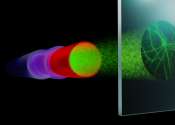Record-breaking metalens could revolutionize optical technologies
Traditional lenses—like the ones found in eyeglasses—are bulky, heavy and only focus light across a limited number of wavelengths. A new, ultrathin metalens developed by researchers at the University of California, Berkeley, ...









